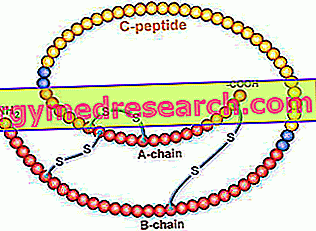Generality
Peptide C is a peptide fragment embedded in the precursor insulin protein, pre-proinsulin.
The measurement of this peptide in the blood is interesting from the clinical point of view, thanks to a half-life (20 minutes) higher than that of insulin (5 minutes). Furthermore, peptide C does not react with anti-insulin antibodies.
Anti-insulin antibodies
In people with diabetes who follow an insulin-based treatment, antibodies against the insulin can form, making it impossible to dose. In these cases, to assess the residual functionality of pancreatic beta cells, the dosage of the peptide C is used, thus avoiding unreliable insulin values.
What's this
Insulin synthesis and formation of the C peptide

Again due to the intervention of some enzymes, within the secretory granules, proinsulin is transformed into definitive insulin, by removing a peptide, the so-called conjugation peptide or peptide C.
After the proteolytic cutting of the C peptide, the two remaining subunits (A and B) remain united by chemical interaction of some amino acids; thus originates insulin, a notoriously essential hormone for the regulation of blood glucose .
Although it does not act directly on blood glucose, the peptide C is not something superfluous; in fact it carries out some important biological functions (it increases the release of nitric oxide, it intervenes in the repair of the muscle tissue of the arteries and protects the body against some diseases typically associated with diabetes).
Peptide C is metabolized in the kidneys and can also be dosed in urine.
PLEASE NOTE: a peptide C molecule is also circulated with each insulin molecule.
Peptide C, Diabetes and blood tests
Although exposed, insulin and peptide C are secreted in equimolar amounts, but despite this, due to the greater half-life, the plasma concentration of Peptide C is higher.
Even if the relationship is not equitable, the blood concentrations of this molecule still reflect the endogenous insulin synthesis; therefore, if blood levels of C peptide are presumably low, insulin synthesis is also low .
In diabetic people we should therefore expect low levels of C peptide; actually quite often the opposite is true. In fact, remember that in the early stages of type II diabetes insulin is normally increased ( hyperinsulinemia ) and with it the levels of peptide C. This is because in such situations, rather than missing the insulin itself, the sensitivity of the cells is lost. to its action; we speak, not surprisingly, of insulin resistance . Only in a late phase, the chronic overload of the pancreas - intent on secreting greater quantities of insulin to compensate for the poor cellular response - leads to a slow functional decline of pancreatic β cells, with a decrease in insulin and peptide-C.
This diabetic form, typical of the senile age, is contrasted with the so-called type I diabetes mellitus, characteristic of youth and caused by an important defect of insulin secretion following an immune attack against pancreatic β cells.
Why do you measure

The advantage of determining the C peptide with respect to that of insulin is that the former reflects in a more satisfactory manner the real state of secretory activity of pancreatic beta cells, which are responsible for insulin production. This test allows to measure, in fact, the rate of endogenous insulin, that is produced by the body, even in case of administration of exogenous insulin (injections in diabetic patients) or in the presence of anti-insulin antibodies that interfere with the dosage of hormone.
The measurement of the C peptide is also useful as a support for the diagnosis of insulin-secreting pancreatic beta-cell tumor ( insulinoma ).
In 24-hour urine, the C-peptide assay is useful when it is necessary to continuously evaluate beta cell function.
Normal values
The reference values of the C peptide in the blood are between 0.78 and 1.89 ng / mL.
Note: the normal ranges may differ in the various laboratories, as they depend on many factors, such as analytical methods and instrumentation in use.
For this reason, it is preferable to consult the normality values reported directly on the analysis report. It should also be remembered that the results must be assessed as a whole by the medical doctor, who knows the patient's medical history.
Peptide C High - Causes
Peptide C increases under the following conditions:
- Non-insulin-dependent (type II) diabetes;
- Insulinoma;
- Taking oral hypoglycemic drugs to control blood sugar;
- Kidney failure.
Increases in peptide C can also be caused by chloroquine and oral contraceptives.
Peptide C Low - Causes
A reduced level of C peptide can be found in the case of:
- Insulin-dependent diabetes;
- Hypoglycemia caused by insulin administration;
- Pancreatic removal operation (radical pancreatectomy).
How to measure it
Peptide C can be measured in blood or 24-hour urine.
For blood dosing, a venous blood sample is taken, generally at the elbow bend.
Preparation
For blood sampling, it is necessary to observe a fast of at least eight to ten hours, during which a small quantity of water is allowed. It must also be in an upright position for at least 30 minutes.
Interpretation of Results
For what said:
- In patients with type I diabetes, the levels of peptide C in the blood and urine are very low (in parallel with those of insulin, which must be administered from the outside);
- In patients with type II diabetes, peptide C levels are often normal or above normal. The same situation occurs in people whose blood sugar levels are high, but not yet high enough to be able to talk about manifest diabetes (we prefer to talk about insulin resistance).
In insulin-dependent patients, the blood dosing of the C peptide allows to evaluate how much insulin is produced by the body, since the exogenous one (injected) lacks the conjugation peptide.
For the same reason, if the concentration of glucose in the blood is low ( hypoglycemia ), as well as the levels of peptide C, then this condition has presumably been generated by an excessive dose of insulin ( hypoglycemia factitia with hyperinsulinemia ) or oral hypoglycemic agents ( hypoglycemia factitia with hypoinsulinemia ).
By monitoring the levels of C peptide over time, the physician has the opportunity to establish with precision the course of residual secretion of β cells.
Finally, the blood dosing of C peptide - also evaluated after glucagon injection - is useful in the diagnosis of insulinoma, a tumor that affects pancreatic β cells causing hyperinsulinemia associated with hypoglycemia and elevated levels of C peptide in the blood (even after glucagon injection ).
GLYCEMIA | PETIDE-C | POSSIBLE CAUSE |
High | High | Type II diabetes, gestational diabetes, pre-diabetes, insulin resistance (often resulting from polycystic ovary syndrome, Cushing's syndrome and obesity). |
Low | High | Insulinoma, excessive use of oral hypoglycemic agents, such as sulfonylureas and meglitinides. |
High | Bass | Type I diabetes mellitus, advanced type II diabetes. |
Low | Bass | Liver disease, severe infections, Addison's disease, injection of an overdose of insulin. |
PEPTIDE C (fasting, reference values) | GLYCEMIA (fasting, reference values) | |||||||||
Variables from laboratory to laboratory |
|



